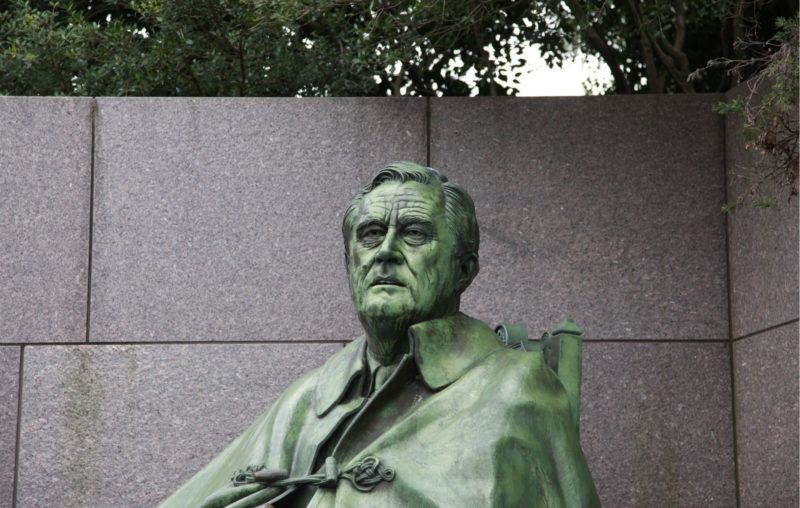How FDR Killed Federal Anti-Lynching Legislation

December 1939 marked an unusual moment in American politics. Although a raging world war consumed the European continent and the distant perimeter of the Pacific, the United States remained two years away from entry into the conflict. Instead, the domestic political landscape focused upon the approaching 1940 presidential election and what it portended for the future of the New Deal economic program.
Franklin Delano Roosevelt, the incumbent president, was approaching the end of his second term. While no formal mechanism prohibited him from seeking reelection, a longstanding convention dating to the presidency of George Washington had thus far dissuaded any president from seeking an extension of his term beyond the associated 8-year limit. A presumptive successor to Roosevelt for the Democratic nomination also waited in the wings, his own Vice President John Nance Garner.
“Cactus Jack” Garner, as he was known from an old campaign trail nickname, led the early polls among Democratic voters. Although he backed most of Roosevelt’s legislative agenda over the previous 8 years, including playing an important bridge-building role as presiding officer of the Senate during the New Deal legislative battles, he also hailed from a more fiscally conservative wing of the party that worried about the long-term strains of deficit spending and that exhibited reservations about executive overreach, exemplified in his break with FDR over the failed court-packing scheme of 1937.
After months of speculation and favorable poll numbers, Cactus Jack broke his silence on December 17, 1939 with the announcement that he would “accept the nomination for president” in 1940. The news practically elevated Garner to presumptive nominee, with no other clear contenders in the field. No contenders, that is, except for Roosevelt himself, who was quietly preparing to break with Washington’s convention and seek an unprecedented third term.
As Garner mapped out his campaign, he turned to counting the prospective electoral votes in a November contest against the Republicans. The Texan expected to retain the Democratic strongholds of the “solid south” and aimed to continue the sweep of the western states that propelled his previous ticket into office in 1932 and 1936. The Republicans’ best chances of an electoral upset relied on reconstituting its pre-Depression bases in the population-heavy regions of the Northeast and Midwest, much of which would depend on who they selected as their own nominee in the coming months.
Although his motives were likely more opportunistic than principled, Garner recognized a potential wedge issue that would help to secure an untapped voting block for the Democratic campaign: African-Americans in northeastern and midwestern states, who faced comparatively fewer encroachments on their right to vote than in the southern states of the Jim Crow era. Hoping to secure this voting bloc for his own presidential ambitions, Garner began circulating rumors in January 1940 that he would use his position as presiding officer of the Senate to secure a federal anti-lynching law.
The rumor signaled a reversal by Garner, who previously opposed such legislation and played a role in allowing a similar bill to die under a southern Democratic filibuster in 1937. His announcement was therefore more a matter of worldly politicking than virtue, though it nonetheless offered a chance to break a longstanding deadlock that had impeded such legislation for more than two decades.
The Anti-Lynching Bill dates to 1918 when Republican congressman Leonidas Dyer, who represented a district in St. Louis with a large African-American population, introduced a proposal to allow for the criminal prosecution of lynching at the federal level. Dyer’s bill targeted both the act of lynching and local elected officials in the south who tolerated the practice by refusing to prosecute its perpetrators. It followed an epidemic of racial terrorism in the form of the lynch mob. This systematized practice of extrajudicial murder claimed an estimated 4,000 victims in the late 19th and early 20th centuries, subjecting its predominantly African-American targets to torture and dismemberment in the process.
Although the Dyer Anti-Lynching bill passed the House of Representatives in 1922 and secured a pledge from President Warren G. Harding to sign the measure, it died in the Senate due to a filibuster by the southern Democratic bloc. Elsewhere it attracted bipartisan support. Democratic Senator Edward Costigan of Colorado revived a bill based on Dyer’s proposal in 1934, believing that he could push the measure through the Senate with a coalition of northern and western legislators from both parties. As with its predecessor, Costigan’s bill easily passed the House during a succession of attempts, only to die under a southern filibuster in the Senate. Roosevelt declined to champion Costigan’s measure in advance of the 1936 election out of a belief that it would imperil his support in the South.
New York Sen. Robert Wagner made another post-election push for the Anti-Lynching Bill in 1937 and 1938 only to encounter the same problem. This time Roosevelt’s wife Eleanor publicly signaled her support for the measure, but the president himself remained silent and declined to spend his political capital on securing the bill at a time when the legislative success of the New Deal economic agenda depended on southern Democrats. The Anti-Lynching Bill once again faltered in the Senate, with Vice President Garner declining to weigh in against the filibuster. After a complex succession of parliamentary maneuvers in the Senate the measure was effectively sidelined in exchange for the southerners dropping their filibuster, which had also unintentionally impeded the New Deal farm relief bill at the top of the president’s legislative agenda.
It therefore came as a surprise when Garner floated hints to the press that he was ready to reverse positions in early 1940. A bipartisan bill sponsored by Democrat Joseph Gavagan and Republican Hamilton Fish, both Representatives from New York, was placed on the House calendar for consideration after Congress returned from the holidays, and appeared to be headed for a vote during the second week of January. Civil rights groups including the NAACP quickly mobilized a lobbying campaign to secure the measure. The Gavigan-Fish bill passed the House by a vote of 252 to 131 on January 10, and went to the Senate for consideration.
At some point around January 15, 1940, Garner’s aides leaked word that the Vice President was willing to use his influence to forestall another filibuster of the Anti-Lynching bill in the Senate. Although he would not endorse the bill outright, the maneuver would clear the way for a simple majority vote, likely passing the bill. Roosevelt could then sign the law as a retiring lame-duck president without having to face the southern electorate again. Meanwhile, Garner and the Democrats would emerge in a better position in November to make a play for African-American votes in the northern states where they expected to face the strongest Republican competition.
Expectedly, the press saw through the electoral objectives of Garner’s shifting position. As a January 16 dispatch out of Washington observed, “with his sombrero in the presidential ring, [Garner] has changed his tune to the extent of permitting a showdown vote.” Civil rights advocates nonetheless welcomed the move as their best chance in decades to secure a federal Anti-Lynching law. As the same report noted, even this clear electoral ploy represented “an important concession because only a vote is needed to put the measure on the statute books.”
Unfortunately, the plan to permit a vote faltered in the Senate over the next several months, though not for want of trying. Garner failed to account for an unexpected variable: the electoral ambitions of Franklin Delano Roosevelt himself.
At some point in mid-January, Garner approached southern Democrats Alben Barkley, the Senate majority leader, and Sam Rayburn, the Speaker of the House, to present his plan. Although Barkley had joined the southerners in opposing a vote on previous Anti-Lynching bills, he reportedly signaled to Garner that he would acquiesce to the electoral ploy. Garner then took his plan to the president in a private meeting at the White House.
The little-known story of what happened next came to light in 1947 when a former member of Roosevelt’s cabinet relayed a conversation with the president in his memoirs. Shortly after the meeting with Garner, Roosevelt directed an aide to summon Postmaster General Jim Farley to the White House for a dinner meeting with himself, the first lady, and his personal secretary Missy LeHand. In addition to his role in the cabinet, Farley was a powerful political operative. He previously managed Roosevelt’s successful campaigns in 1932 and 1936, and was serving a dual role at the time as the chairman of the Democratic National Committee.
As Farley relayed it, “the Boss” – as he called FDR – opened the conversation by telling a story. “Jim,” the president confided, “I have the grandest joke for you.” Roosevelt spoke:
“I had Garner, Barkley, and Rayburn in this morning for a conference on the anti-lynching bill. And you’ll never guess what Jack said. Very seriously he said that he had given considerable thought to the legislation and that he felt that the colored vote in the border states and in the Northern cities was such that he thought the legislation had to be passed.”
As Farley recounted, “Roosevelt threw back his head and laughed till tears came to his eyes.” The president continued: “Don’t you love it? … Jack has done a complete about face on it now that he’s out looking for votes. Don’t mention it to a soul, though.”
Farley responded: “Boss, it’s really childish not to mention it…You are going to be reading about it, because some of the Congressional leaders are bound to talk.” How the president reacted to this advice is lost to history, although Roosevelt’s instruction to maintain silence about Garner’s plan appears to have come to fruition.
On February 8, bill co-sponsor Hamilton Fish took to the House floor. The American people, Fish noted, “are entitled to know where President Roosevelt stands on the anti-lynching bill and what he proposes to do to help secure its passage in Congress.” Roosevelt demurred on an answer, and Garner appears to have effectively abandoned his plan in the absence of the president’s support. Although the Gavagan-Fish bill received a favorable report out of committee, the threat of a southern filibuster before the Senate prevented any further action. Barkley allowed the measure to linger without a vote until October 8, 1940, when he tabled the Anti-Lynching Bill and moved the body into recess for the election season. Proceeding with debate, a press report noted at the time, “would lead to a certain and time-consuming filibuster” that threatened to sidetrack the Democrats’ other legislative agenda items.
Garner’s own bid for the presidency faltered that summer when Roosevelt accepted a carefully-arranged “invitation” from the Democratic convention to run for a third term as conveyed to the gathering by a phone call to Barkley. Though it is difficult to contextualize such a dramatic event in today’s media-driven campaign environment, Roosevelt’s maneuver sent shockwaves through his own party. For months he had studiously avoided public comments on the subject of a third term, and even deceived Farley about his intentions shortly before the gathering by suggesting to the DNC chair that he was prepared to retire after the election named a new successor. In the ensuing fallout, both Garner and Farley made their own bids for the nomination, only to be sidelined at the convention when Roosevelt conveyed that he would accept the offer of a third term.
The Anti-Lynching Bill was but one small side-story to the strange succession of events, which also ended in Garner being replaced on the ticket by Henry A. Wallace, the president’s far-left Agriculture Secretary and a devoted New Dealer. Farley, who had briefly been considered as a Vice Presidential replacement as well, broke from the president on the third term issue and departed the administration a little over a month later.
Yet the Anti-Lynching Bill may also be considered a casualty of Franklin Delano Roosevelt’s political ambition. As press accounts from early 1940 indicated, and as Farley’s memoirs confirm, Garner’s own electoral aims – opportunistic as they were – had the effect of creating a pathway around a Senate filibuster of the bill. Roosevelt however, wishing for a third term of his own, had but a single answer when relaying Garner’s pitch: “Don’t mention it to a soul.” His instruction helped to keep Garner’s campaign in check, but also effectively sealed the fate of the bill.
Although Farley’s account of Roosevelt’s orders would not become public for another seven years, the administration’s inaction on the measure did not go unnoticed. On October 31, 1940, only five days before the election, heavyweight boxing champion Joe Louis appeared at a political forum in Harlem. Standing in front of an audience of 4,000 and initially receiving some jeers over his public endorsement of Roosevelt’s opponent Wendell Willkie a few weeks earlier, Louis approached the podium to explain his reasoning: “If Mr. Willkie is elected…he has promised in writing to put over the anti-lynching bill. Roosevelt has been in office for eight years and done nothing about that. The people in the North don’t know how long is eight years.” The crowd at first went silent, then erupted in cheers at the boxer’s message to the incumbent president.
Roosevelt went on to win a third and fourth term. As Louis predicted, the federal Anti-Lynching bill saw no further action on his watch.










